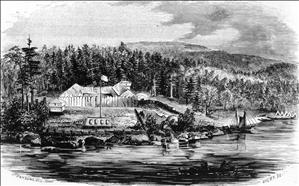On November 15, 1813, North West Company partners Alexander Henry the Younger (d.1814), Alexander Stewart (sometimes spelled Stuart) (ca. 1780-1840), and clerk James Keith (1782-1851) arrive at the mouth of Columbia River after a canoe journey across the continent from Fort William, on the shores of Lake Superior. Henry's journals provide an inside look at a "critical point of Anglo-Canadian and American business rivalry" between the North West Company of Montreal and the Pacific Fur Company of New York (Henry, Vol. 1, p.lv).
To Strengthen Company Interests
Alexander Henry and his 18-man party had departed Lake Superior four months earlier, assigned to "strengthen the Company interests across the mountains" (Henry, Vol. 1. p. xxxi) in the Columbia District, where the Nor'Westers were battling John Jacob Astor's (1763-1848) fledgling Pacific Fur Company. The outbreak of the War of 1812 the previous year had disrupted the normal routines of the business, and Henry's party was instructed to proceed down the Columbia River to assist resident partner John George McTavish (ca. 1778-1847).
Pacific Fur Company clerk Gabriel Franchere (1786-1863) recorded the Canadians' arrival: "They brought us some Canadian newspapers, from which we learned that to date British arms had had the advantage. They also confirm the news that a frigate was to come to seize our former establishment and they even seemed surprised not to see the Isaac Todd in the roadstead" (Franchere, 131). The Isaac Todd was a North West Company supply ship en route from London, accompanied by a British warship dispatched by the British Admiralty to capture all American establishments near the Northwest coast.
Henry found McTavish and a party of Nor'Westers installed at Fort Astoria, the post built by Astor's company in 1811 on the southern shore of the Columbia. McTavish had recently descended the river from his headquarters at Spokane House and had negotiated a purchase agreement for all of the Pacific Fur Company's property in the Northwest, which included Fort Okanogan and Spokane House in the interior as well as Fort Astoria.
Both companies were running low on trade goods, and the Nor'Westers anxiously awaited the arrival of their supply ship Isaac Todd and her armed escort, while fearing the sudden appearance of an American warship. Meanwhile, the Astorians found themselves in limbo -- it was impossible to estimate whether an American ship might reach the Columbia anytime soon to carry them back to New York, and it was too late in the fall to attempt to cross the Rockies. The Nor'Westers had agreed that their former rivals could remain in their posts until spring when the overland route to the United States would be open, and had hired several Astorian clerks and workers for their expanded operations.
The Canoes Are Many
Alexander Henry, who had spent his fur trade career on the Canadian Prairies, observed with great interest the coastal environment and the culture of the local Chinook Indians. "Their canoes are many," he wrote, "one for the Sea, one for the River, and the smaller kind for fishing" (Henry, Vol. 2, p. 610). One afternoon he watched the Chinook chief Comcomly cross the Columbia in a large sea canoe, "paddled by six men, one at each end, and the other four two abreast. They kept regular time in paddling. Their manner of loading is stern foremost, this is with a view to preserve the sharp stern of the canoe, and at the same time break the surf and prevent the canoe from filling with water" (Henry, Vol. 2, p. 610).
Henry was curious to explore the landscape around the mouth of the Columbia. As soon as the weather permitted, he found a seat in a canoe heading across the river to the north shore (present-day Pacific County). "We landed on Chinook Point, on very high surf which we somewhat avoided by landing near a point of rocks above the Villages, where we hauled our Canoes on the sand" (Henry, Vol. 2, p. 612). They visited three Chinook villages but found that most of the inhabitants were away at remote fishing sites. Henry sampled "hurtleberries" (huckleberries) offered by a woman at one of the villages, and measured one "House which was 70 feet long, and 25 wide, the door in the gable end as usual" (Henry, Vol. 2, p. 613).
He then climbed Chinook Hill (now known as Scarboro Hill), which he called Red Patch due to a dried fern that covered its surface and was visible from the sea. From the top of the hill, he reported a grand view of Point Adams to the south, Cape Disappointment and Bakers Bay to the west, and Grays Harbor to the north. The tide was high, and the Columbia bar appeared to be a solid body of foam except for a narrow channel near the center.

